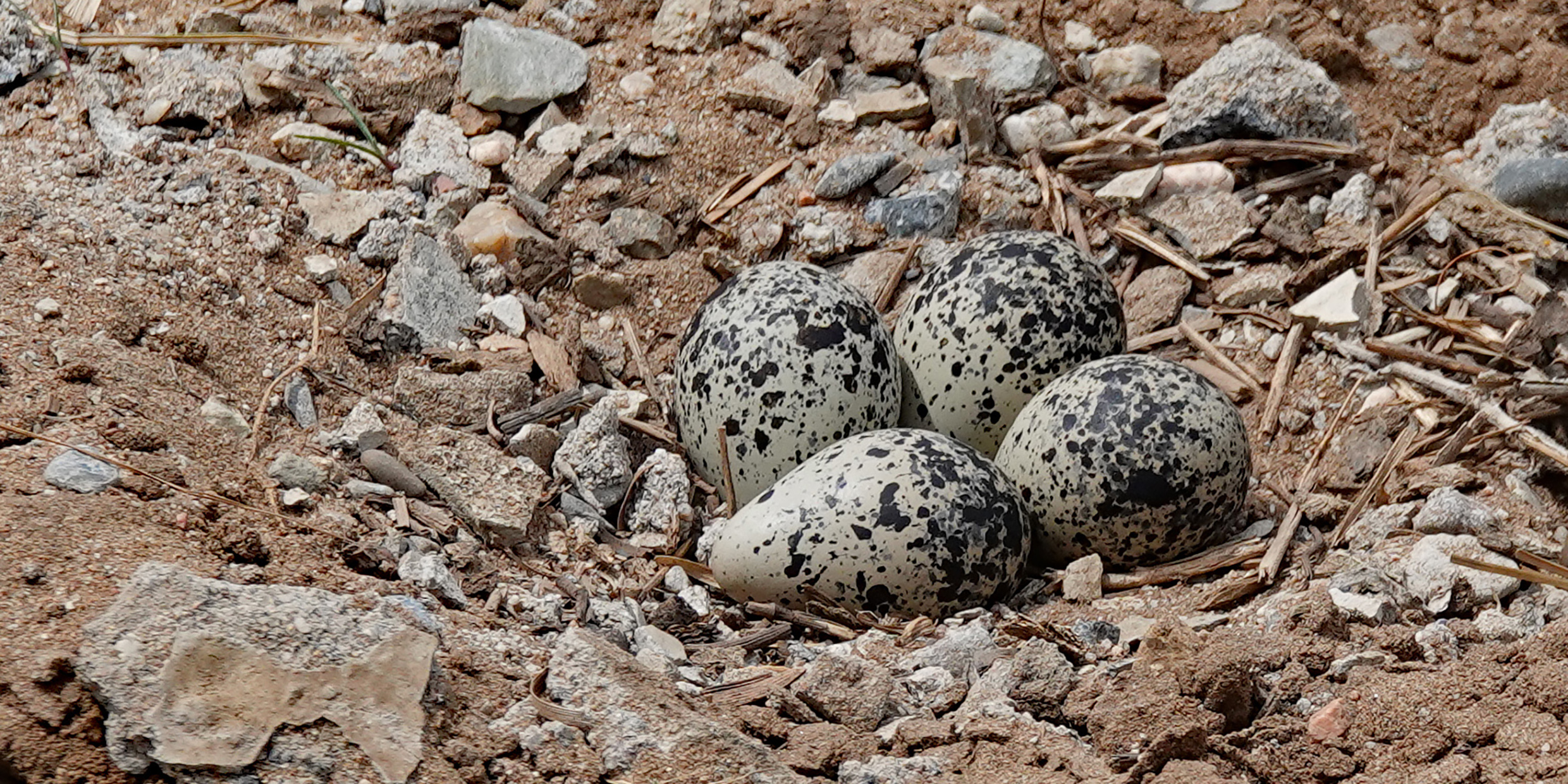Originally published 8 May 1995
Why do killdeers build their nest on open ground?
Nearby are woodlands, thickets, a field of rough boulders, all seemingly providing more security. Yet here is the nest on naked earth, among tiny twigs and stones.
Which is not to say that the nest is obvious. Each day when I return to check the progress of the eggs, it takes me a few moments to see the brooding parent, and I know exactly where to look. Her brown, black, and white coloration blends perfectly with earth, twigs, and pebbles. When she leaves the nest (or is it he? the sexes are almost indistinguishable), the eggs themselves are even more difficult to discern: speckled brown ovoids in a shallow saucer of wood chips.
The killdeers seem to be acting on the principle that less is more. If you are building your nest in the open, then the nest itself should be inconspicuous — a shallow scrape in the earth, a few bits of debris.
Killdeers do not choose their nesting site at random. They are driven by instinct to open ground. The architecture of the nest is likewise innate to the species, as much a part of the killdeer’s genetic inheritance as the shape and color of the eggs.
I want to talk about instinct. But first let me address a fan letter to Don and Lillian Stokes, Massachusetts naturalists and authors of the Stokes Nature Guides, published by Little, Brown. I own all of these wonderful guides — birds, insects, wildflowers, amphibians, etc. — two copies of several, one for home and one for the office.
Unlike many field guide authors, the Stokeses make no attempt to be species comprehensive. Rather, they focus on a few dozen common species and treat them in depth.
The day I came across the killdeer nest, I went immediately to my Stokes Guide to Bird Behavior. Here I can find everything I need to know about killdeer behavior, not just what to look for, but when and how to look.
I discovered, for example, that a typical nest contains four eggs (mine has three), that incubation takes 24 – 28 days, and that if I want to see the nestlings I had better be there when they hatch, because within an hour or so they are out of the nest, never to return.
Knowing what to look for doesn’t mean there is nothing new to discover. The Stokeses say that killdeer parents regularly turn the eggs to keep them evenly warm, but do not mention that the eggs are placed with the pointy ends together, the most compact arrangement. This alignment has been too rigorously maintained in the nest I am watching to be an accident — another behavior that is apparently coded in the genes.
Approach the nest too closely, and you are in for a show. The parent leaps from the eggs and begins a frantic diversion, calling furiously (the scientific name of the bird is vociferous), spreading the tail, flopping the wing as if it were broken, skittering about the ground, doing everything possible to distract the intruder from the nest — a bit of instinctive parental devotion that leaves one gasping with admiration.
Which brings me to my subject.
Consider for a moment just one of the behaviors I have described: arranging the eggs with the pointy ends together. Why do killdeers do this? Answer: They are impelled by instinct.
Inside each of the three eggs in my killdeer nest is an embryo that has already been instructed on arrangement of eggs. As the killdeer’s tiny brain takes form, an impulse to turn eggs pointy ends together is built into the circuitry.
Let’s go further back, to the first microscopic fertilized cell which will become the embryo. In the cell is a strand of DNA, the famous double helix. Along the strand, four chemical components, called organic bases, are arranged in pairs: A‑T, C‑G, T‑A, G‑C. It is the sequence of base pairs that is the genetic code. Somewhere along the strand is a sequence that arranges eggs.
We know it’s true. But it almost surpasses belief.
All of the behaviors described by the Stokeses (circling-flights, horizontal-run, collar-show, scraping, side-tilt, bobbing), all the auditory displays (kideah-calls, stutter-call, pup-pup-call), all of the characteristics of killdeer courting, feeding, parenting, and flocking, including the efficient arrangement of the eggs, are spelled out in a helical strand of DNA in the nucleus of a cell that is too small to be seen.
As I stand 20 feet away from the killdeer nest, with my Stokes guide in my pocket, staring through my binoculars into the suspicious eyes of the brooding bird, I am suddenly struck with the immense improbability of it all, the improbable miracle of life.
Chemistry, apparently. All chemistry. But don’t let anyone say “only chemistry.” This is chemistry infused with a cosmic spark we have only begun to understand.
Postscript: Since I wrote this, the killdeer’s habit of building an inconspicuous nest on open ground has resulted in disaster. Someone unknowingly dumped landscaping refuse directly onto the nest. I excavated the eggs intact, but the parents didn’t return. A day later the eggs were gone.



